Festival for a town that doesn’t conform
Lucy Hawthorne: Unconformity, Queenstown, Tasmania
.jpg)
Katrina Gill, Dark Water, Unconformity Festival
Queenstown is a place of contradictions and mythologies. On one hand, the small town on Tasmania’s rainy and remote west coast seems like an unlikely place for an interesting and challenging festival, with director Travis Tiddy acknowledging the “absurdity of having an arts festival in ‘a regional backwater’ on the fringes of cultural activity in the state.” Yet at the same time, its unique landscape, history of mining and changing fortunes makes it a natural location for site-specific art and performance. This year, the name changed from the didactic Queenstown Heritage and Arts Festival to The Unconformity, which refers to a local rock form, the Haulage Unconformity (a touching point of three geological agents). But it’s equally indicative of the festival’s mission to represent an isolated community that doesn’t conform. It’s a festival that embraces the unexpected.
Driving from Hobart to Queenstown is a lesson in the extremes of the Tasmanian landscape. For visitors like myself, travelling there is an integral part of the festival experience. From the Derwent Bridge it’s a winding and hilly crossing through the largely impenetrable South West Wilderness. Emerging in Queenstown, I’m greeted by near naked hills—the result of widespread deforestation due to bushfires, mining and its consequential sulphur fumes, acid rain and erosion. This landscape is still mythologised as a ‘moonscape,’ despite the gradual regrowth.
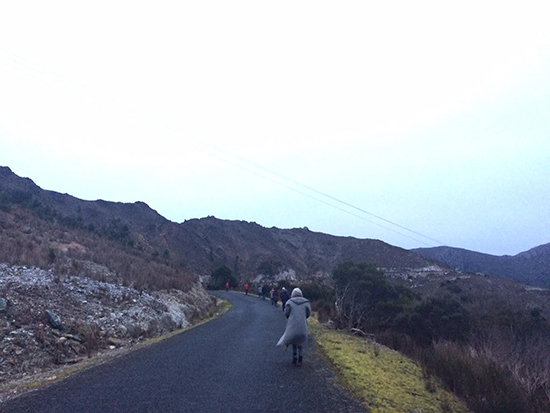
Participants in We Are Mountain, Mish Grigor, Zoe Scoglio, Unconformity Festival
We are mountain
It’s on this rocky peak that Mish Grigor and Zoe Scoglio’s participatory performance, We Are Mountain, is based. The respectively Sydney and Melbourne-based artists became obsessed with the mountain during a recent visit, declaring, “Let’s be the mountain.” We are loaded onto a bus and driven up via hairpin bends to the Iron Blow lookout while an audio guide-like voiceover provides facts about the history and geology of the site. I learn that Iron Blow was the original open-cut mine established by the Mount Lyell Mining Company in 1884. Audience members from Queenstown laughingly add their own impromptu facts, including a story about one local who was seen throwing whitegoods off the lookout into the now water-filled hole. We are dropped at the turnoff to the lookout and instructed to walk single file slowly up the road. “Feel the ground beneath your feet. Really feel it,” the artists instruct us. We take turns yelling “cooee” off the lookout, listening to the echoes until the wind and horizontal rain force us away from the edge.
My initial admiration for the artists’ bravery and untempered enthusiasm, hosting a dusk performance outdoors in a town where clear days average only 29 a year, turns a little sour as my beanie is whisked away by the wind. At this point, the performers’ spirit of play and celebration seems to far outstrip that of the audience. Their improvisational style and humorous commentary match the absurdity of the situation. One of the pair climbs up a short slope in an attempt to “be legendary.” Exaggerating her struggle up the rocks, she breaths into the microphone, “I feel like one of those white guys who discovered something.”
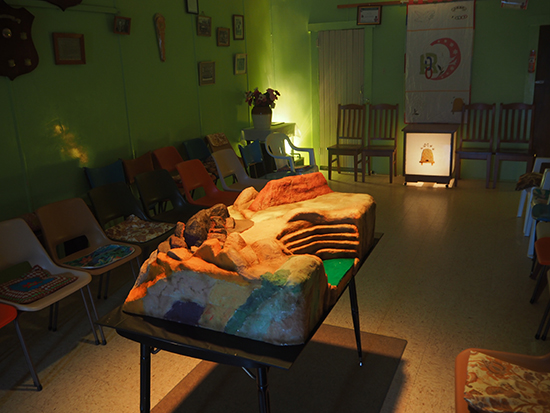
Replica of The Iron Blow in cake, We Are Mountain, Mish Grigor, Zoe Scoglio, Unconformity Festival
We soon return to town to feast on a replica Mount Lyell fashioned from cake. As we descend into Queenstown to the sounds of ambient music and the occasional recorded cooee, we’re provided with stunning views of Jason James’ light installation, part of the Flux program, in the far-off quarry—a representation of the festival’s thematic and aesthetic coherence.
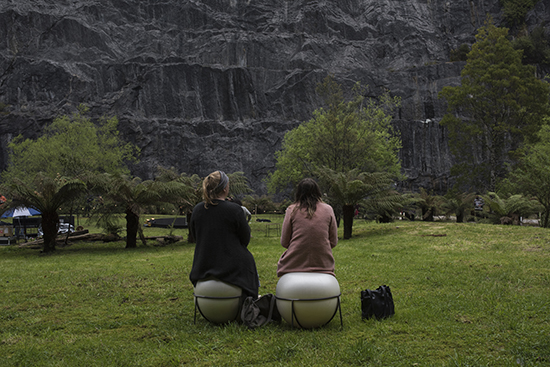
Flux, Unconformity Festival
Flux
The former limestone quarry-turned-garden with its deep cliffs, natural waterfall and pond proves to be a dramatic and magical music bowl and performance space. With no specific Flux program published, the series of free rolling performances by artists and musicians like Pip Stafford, Omahara, Rob Thorne and Jacqui Shelton encourages visitors to embrace the unexpected and return again and again throughout the festival, despite the lack of shelter from the weather.
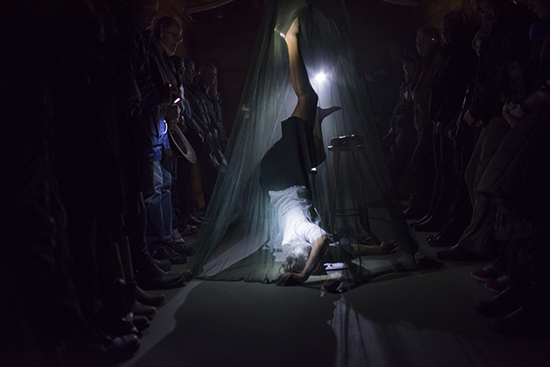
Katrina Gill, Dark Water, Unconformity Festival
Dark Water
Like Flux and We Are Mountain, Dark Water (writer Halcyon McLeod) also uses a former mining site as a performance space. Boarding a train at Queenstown’s station, we end up in one of the former Mount Jukes mines around midnight. Over the journey, the initially well-dressed female train attendant (Katrina Gill) becomes increasingly distressed as she descends into grief. The soundtrack, provided via wireless headphones, is a steady monologue of her progressively disconnected thoughts.
The performance is initially sited in a largely empty carriage. Holding onto the walls against the train’s jolting, we form a natural arena around the attendant. For a show about grief, Dark Water has some oddly humorous moments, such as when the attendant stuffs a pudding into a stocking and shoe, creating an object that half-resembles a rock, or a surreal decapitated leg. As we alight at Lynchford station and walk into the train’s blinding headlights, we’re calmly told “she pushes a crystal as big as a bus” as the now dishevelled attendant, pulling her skirt off, runs angrily at the train. The humour is dark—and perhaps represents a therapeutic strategy in the context of sadness and mourning.
The train, the historical stations and the cold, dark mine are fascinating. However, the wireless headphones distract from the performance and surroundings. While the journeying admittedly makes it difficult to provide a constant source of sound, the headphones seem like a poor solution. Aside from the technical problems (mine kept dropping out), the headphones blocked the all-important sounds of the moving train, the river alongside Lynchford station and the drips in the mineshaft. In a steady beat, the water drops into the pools around our feet, echoing in the deep, narrow tunnel, representing the passing of time and an emotional hollowness. Wireless technology works well when isolating and noise blocking effects are integral to the performance, but not here.
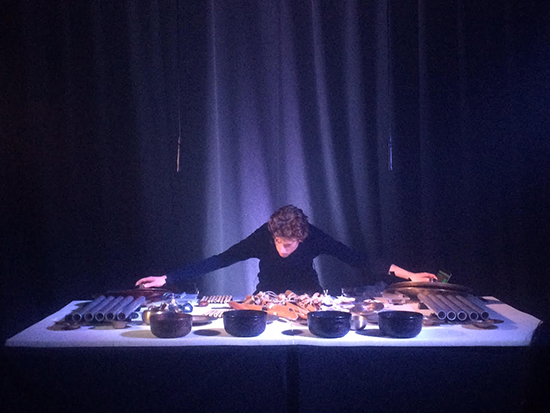
Fault Traces, Matthias Schack-Arnott, Unconformity Festival
Fault Traces
Away from the mountain but still geology-themed, Matthias Schack-Arnott’s Fault Traces in the Boy Scout Hall evokes the deep rumble of industry using subsonic frequencies and a variety of resonant objects, including metal, bamboo, rocks, bowls and nets of seashells. Bending over the carefully arranged groups, positioned on a “panel activated by tactile transducers which are fed low-frequency information,” the composer appears half-performer, half-conductor as he orders and reorders objects. Schack-Arnott maintains a swift but light touch despite the increasingly violent frequency vibrations, allowing us to concurrently hear, feel and ‘see’ the various soundwaves.
Geologies
A performance installation, Geologies, explores the body as “inherited geology.” This collaboration between composer and visual artist Leigh Hobba and dancer Wendy Morrow is performed within Queenstown’s Masonic Hall on a crystal-shaped raised stage. The surrounding lights glow through textured woodblock prints that resemble rock faults. Performed by the Southernwood String Quartet led by Thibaud Pavlovic-Hobba, the music is lively and exciting. Hobba at one stage crosses into the audience, playing harmonics to produce a soft, chimelike accompaniment to Morrow’s fluid movements.
Leigh Hobba introduces each movement with a series of words and ideas (“dissonant, river, composure…”) that acts as an interpretative tool, invoking visual images or emotions to overcome the fragmentation and atonality of his score. Although the performance is anything but predictable, Hobba finishes with an announcement: “and then to anticipate…. this!” before leaping at the adjacent piano and striking out a dissonant chord.
Again, art comes back to the unexpected—a theme that describes Queenstown’s serial changes in fortune as much as the festival’s critical edge. The 2014 festival followed multiple mine fatalities and subsequent closure of the Mount Lyell mine, resulting in a significant economic downturn. During the 2014 opening address, the five-metre-tall Angel of the West sculpture (intended to symbolise hope and resilience) accidentally caught fire, an unintentional yet tragically fitting metaphor for a once booming mining town now suffering depression and decay. The Unconformity does not run away from these gritty truths, nor does it romanticise the past. With a criticality that’s rare in arts festivals, The Unconformity is a celebration of community, geology and history in all their contradictions and ‘unconformities.’
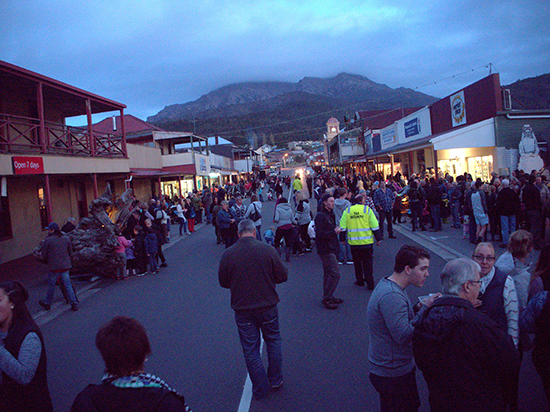
Unconformity festival-goers, Orr Street, Queenstown
For more Unconformity, read about British artist Lindsay Seers’ video installation, Suffering, about the late Leo Albert Kelly, a Queenstown painter and collector of found objects and an interview with festival director Travis Tiddy.
The Unconformity, Queenstown, Tasmania, 14-16 Oct
RealTime issue #135 Oct-Nov 2016






